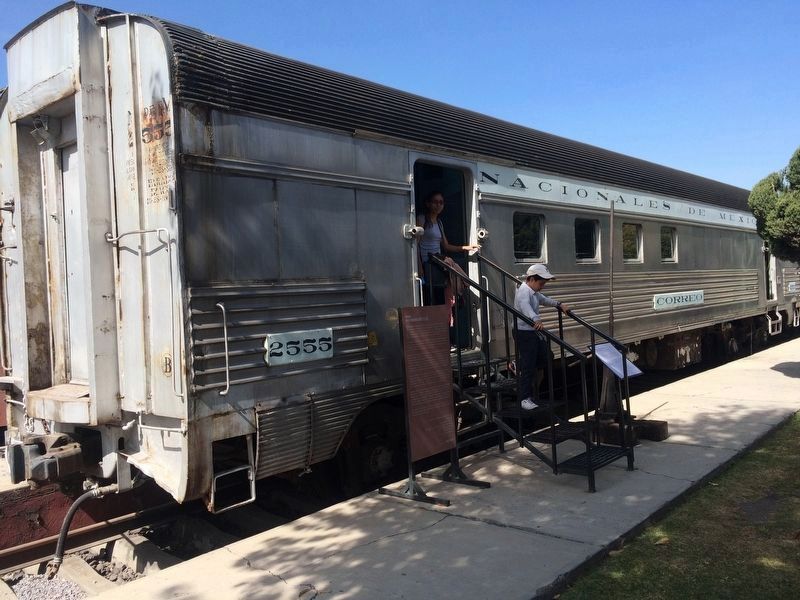Puebla, Mexico — The Central Highlands (North America)
Mail Car NM 2555
Coche
correo NM 2555
EI Museo Nacional de los Ferrocarriles Mexicanos resguarda y protege alrededor de noventa piezas de equipo rodante que representan una parte importante del patrimonio material ferrocarrilero que existe en México. Entre estas piezas destaca como pieza única en el país, el coche correo NM2555.
El servicio de transporte de correspondencia comenzó a funcionar por primera vez en Estados Unidos en 1835. En México lo hizo a mediados del siglo XIX, con el primer ferrocarril que circuló en el país, el de Veracruz a El Molino de San Juan.
En sus inicios, el servicio postal ocupó sólo una parte de algún carro, pero poco tiempo después, con el incremento de la correspondencia, se adaptaron carros para tal fin. Conforme pasó el tiempo se hizo necesario construir coches con el fin ex profeso de manejar y distribuir la correspondencia, a lo largo de ciertas rutas ferroviarias. En el tren, el coche correo se ubicaba, por lo general, detrás de la locomotora o del coche express, si es que lo llevaba.
El coche NM 2555 se utilizó para el servicio postal en las llamadas “rutas rápidas", que eran la de México - Monterrey, la de México - Guadalajara y la de México - Ciudad Juárez. En algunas estaciones de esas rutas se hacía el intercambio de correspondencia; es decir, se dejaba alguna y se llevaba otra.
El NM2525 fue fabricado por la empresa estadunidense The Budd Company en 1954 y comprado por Ferrocarriles Nacionales de México en 1972. La parte exterior de este coche es de acero inoxidable, que es una de las características manufactureras de la Budd Co. Mide casi veinte metros de largo y pesa 43.4 toneladas. Podía cargar hasta 27.7 toneladas de cartas, postales y paquetería.
Este coche se considera pieza única, porque de 23 coches de este tipo que se adquirieron allá por 1970, sólo queda éste. Llegó al Museo en octubre de 1995.
Constructor: The Budd Company, U.S.A.
Clase: MA
Vía: ancha 1.435 m
Ferrocarril en el que dio servicio: Ferrocarriles Nacionales de México
Tara: 43,350 kg
Trucks: Commonwealth
English translation:
Mail Car NM 2555
The Mexican National Railroad Museum safeguards and protects around ninety pieces of rolling stock that represent an important part of the railway heritage in Mexico. Among these pieces, a unique piece in the country stands out, the Mail Car NM2555.
The mail transport service began for the first time in the United States in 1835. In Mexico it was started in the mid-19th century, with the first railroad that operated in the country, that of Veracruz to El Molino de San Juan.
In its beginnings, the postal service occupied only
a part of a car, but a short time later, with the increase in correspondence, cars were adapted specifically for the purpose of carrying mail. As time passed it became necessary to build cars with the express purpose of managing and distributing correspondence along certain routes. On the train the mail car was usually located behind the locomotive or the express car, if one existed.
The NM 2555 car was used for postal service on so-called "rapid routes", which were the Mexico - Monterrey, Mexico - Guadalajara and Mexico - Ciudad Juarez routes. At some stations along these routes there was the exchange of correspondence.
The NM 2555 was manufactured by The Budd Company of the United States in 1954 and purchased by National Railroad of Mexico in 1972. The outer part of this car is stainless steel, which was one of the manufacturing features of the Budd Co. Measuring almost twenty meters long and weighing 43.4 tons, it could carry up to 27.7 tons of letters, postcards and parcels.
This car is considered a unique piece, because of 23 cars of this type that were acquired in Mexico by 1970, only this one remains. It arrived at the museum in October 1995.
Builder: The Budd Company, U.S.A.
Class: MA
Track: 1.435 m width
Railroad in which it served: National Railroad of Mexico
Tare: 43,350 kg
Trucks: Commonwealth
Topics. This historical marker is listed in these topic lists: Industry & Commerce • Railroads & Streetcars. A significant historical month for this entry is October 1995.
Location. 19° 3.176′ N, 98° 12.256′ W. Marker is in Puebla. Marker can be reached from Calle 11 Norte just south of Avenida 14 Poniente, on the right when traveling south. The marker is on the grounds of the Mexican National Railroad Museum, to the left at the first row of engines and cars after the entrance. Touch for map. Marker is in this post office area: Puebla 72090, Mexico. Touch for directions.
Other nearby markers. At least 8 other markers are within walking distance of this marker. Diesel-Electric Locomotives DH-19 and DH-17 (a few steps from this marker); From Steam to Diesel (a few steps from this marker); Electric Locomotive FCM 1001 (within shouting distance of this marker); Nationalization of the Railroads of Mexico - 1937 (within shouting distance of this marker); A National Railroad Network (within shouting distance of this marker); Engine 601 (within shouting distance of this marker); Steam Locomotive NM-601 (within shouting distance of this marker); The Railroad Museum (within shouting distance of this marker). Touch for a list and map of all markers in Puebla.
Credits. This page was last revised on December 13, 2017. It was originally submitted on December 13, 2017, by J. Makali Bruton of Accra, Ghana. This page has been viewed 201 times since then and 10 times this year. Photos: 1, 2. submitted on December 13, 2017, by J. Makali Bruton of Accra, Ghana.

